高强汽车双相钢的连续退火与组织性能研究
杨灿,校振华,冯启生,罗志辉
高强汽车双相钢的连续退火与组织性能研究
杨灿1,校振华1,冯启生2,3,罗志辉3
(1.河南农业职业学院,郑州 451450;2.河南科技大学,河南 洛阳 471000; 3.洛阳中重铸锻有限责任公司,河南 洛阳 471000)
提升高强DP980双相钢的力学性能,优化连续退火工艺。对高强汽车双相钢进行了连续退火处理,研究了连续退火均热温度、均热时间、过时效温度对冷轧双相钢显微组织、物相组织和力学性能的影响。对于不同退火均热温度处理的双相钢,其组织均为铁素体(F)+马氏体(M),随着均热温度从715 ℃升高至865 ℃,残余奥氏体体积分数逐渐减小,抗拉强度、屈服强度先增后减,断后伸长率逐渐减小,在均热温度为815 ℃时,双相钢的抗拉强度和屈服强度达到最大值。随着均热时间从0.5 min延长至5 min,双相钢的晶粒尺寸逐渐增大,残余奥氏体体积分数先减后增,抗拉强度、屈服强度先增后减,断后伸长率先减后增,在均热时间为1.5 min时,抗拉强度和屈服强度达到最大值。随着过时效温度从245 ℃上升至395 ℃,双相钢中的马氏体体积分数逐渐减小,当过时效温度为395 ℃时,出现了贝氏体,奥氏体体积分数先增后减,抗拉强度、屈服强度逐渐减小,断后伸长率逐渐增大。冷轧DP980双相钢适宜的连续退火工艺如下:均热温度为815 ℃、均热时间为3 min、过时效温度为295 ℃。此时双相钢具有较好的强塑性。
DP980双相钢;连续退火;工艺参数;组织;性能
双相钢是主要由铁素体和马氏体组成的低合金高强度钢,由于具有强度高、塑性好、初始硬化率高、成形性能良好等特点,在现代汽车制造中有广泛的应用[1]。目前,双相钢在基础理论研究和最终成品质量方面仍达不到实际应用标准[2],需要进一步在钢种优化(调整化学成分、添加微合金化元素等)、加工技术改进(加工和热处理工艺优化、表面改性技术开发)和创新设计(引入纳米晶、界面控制)等方面加强研究[3],以降低生产成本、提高生产效率和综合性能。在汽车用双相钢生产过程中,冷轧后的双相钢往往需要进行连续退火或者淬火-回火热处理,以稳定组织、改善最终成品性能[4]。目前大部分的研究工作主要集中在DP490、DP590和DP780等强度级别的双相钢及其淬火-回火热处理上[5-7],有关强度级别更高的DP980双相钢的轧后连续退火及工艺参数对组织与力学性能影响的报道较少,其具体影响机制及作用机理尚不清楚[8-9]。因此,本文以更高强度级别的汽车用DP980双相钢为研究对象,考察了连续退火均热温度、均热时间、过时效温度对冷轧双相钢显微组织和力学性能的影响,以期为高强汽车双相钢的连续退火工艺优化及力学性能提升提供参考。
1 试验
1.1 材料
以本钢集团生产的汽车用冷轧DP980双相钢为原料,采用电感耦合等离子发射光谱法测试双相钢的化学成分,结果如表1所示。双相钢组织为铁素体(F)+马氏体(M)双相组织,马氏体的体积分数为49%。双相钢的粗轧温度为1 240 ℃,精轧温度为925 ℃,卷曲温度为620 ℃,热轧厚度和冷轧厚度分别为4 mm和1.8 mm,冷轧压下率为60%。
表1 试验用钢的化学成分

Tab.1 Chemical composition of test steel wt.%
1.2 连续退火工艺
采用连续退火工艺对冷轧DP980双相钢进行热处理,工艺流程如图1所示,可知,连续退火工艺主要包括6个阶段,这里主要研究Ⅱ-均热(均热温度、均热时间)和Ⅴ-过时效(过时效温度、过时效时间)阶段对双相钢组织与性能的影响。采用DIL805A热膨胀仪测得冷轧双相钢的奥氏体转变开始温度c1=688 ℃、奥氏体转变结束温度c3=817 ℃和马氏体开始转变温度s=384 ℃[10]。因此,设定连续退火均热温度为715~865 ℃(其中715 ℃和865 ℃分别介于奥氏体-铁素体两相区和奥氏体单相区)、均热时间为0.5~5 min、时效温度为245~395 ℃(s两侧)、过时效时间为1~8 min。
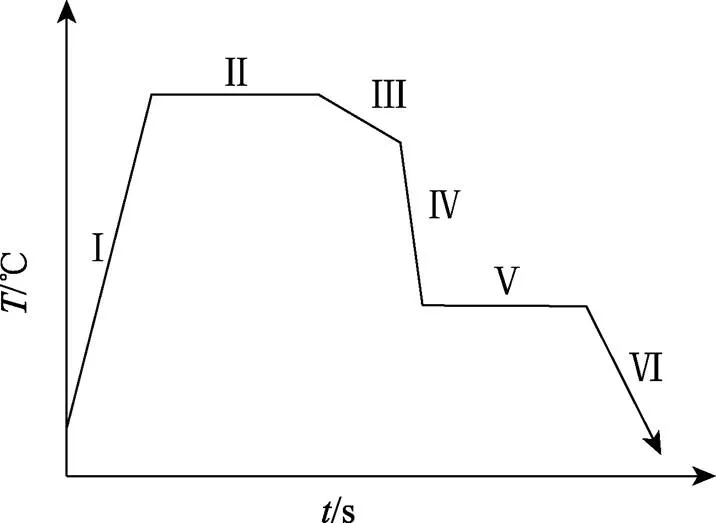
I-heating; Ⅱ-soaking; Ⅲ-slow cooling to 705 ℃; Ⅳ-water cooling; Ⅴ-over aging; Ⅵ-air cooling
1.3 测试方法
采用线切割方法加工块状(10 mm×5 mm)金相试样,经过不同型号砂纸逐级打磨(120#~1500#)、W2.5金刚石研磨膏抛光、4%(体积分数)硝酸酒精溶液腐蚀后,在奥林巴斯GX 51型光学显微镜和日本电子IT 500型扫描电子显微镜上观察显微组织,对每种工艺下的显微组织拍摄15张照片,采用Image-Pro Plus 6.0软件统计显微组织中黑色部分并计算马氏体体积分数;采用布鲁克D8 ADVANCE型X射线衍射仪进行物相分析,并用Jade 6.0软件计算残余奥氏体含量[11-12]。根据GB/T 228—2010《金属材料拉伸试验第1部分:室温试验方法》进行室温拉伸性能测试,拉伸速率为2 mm/min,每组试样加工3根(宽度= 20 mm、标距0=80 mm),并取平均值作为测试结果。
2 结果与分析
2.1 连续退火均热温度
当均热时间为3 min、过时效温度为295 ℃、过时效保温时间为5 min时,不同连续退火均热温度下双相钢的显微组织如图2所示。对比分析可知,经过不同退火均热温度处理后,双相钢组织为亮白色铁素体+黑灰色马氏体,晶粒尺寸较为细小,为2~6 µm,但是由于均热温度不同,双相钢中马氏体形态和马氏体含量存在较大差异。在较低的均热温度(715 ℃)下,双相钢中的马氏体以岛状形态分布在铁素体晶界处;在较高的均热温度(865 ℃)下,双相钢中的马氏体主要以片状形态分布。当均热温度为715、765、815、865 ℃时,双相钢中马氏体体积分数分别为61.2%、67.3%、68.1%和64.5%,可见,双相钢中马氏体体积分数随着均热温度的升高而先增后减,在均热温度为815 ℃时取得最大值。
采用扫描电子显微镜对不同连续退火均热温度下双相钢的显微形貌进行观察,结果如图3所示。在高倍扫描电镜下,可清晰看见马氏体形态,当均热温度为715 ℃时,双相钢中的马氏体呈表面浮凸的孤立岛状。随着均热温度逐渐升高至865 ℃,双相钢中马氏体逐渐演变为片状,而孤立岛状形态马氏体基本消失。
不同连续退火均热温度下双相钢的X射线衍射图谱如图4所示。可见,在不同均热温度下,双相钢都主要含α相和少量γ相,这主要是因为双相钢中的F和M都为bcc结构,在XRD谱图中呈现相同衍射峰。利用Jade 6.0软件计算不同均热温度下双相钢中的残余奥氏体含量,当均热温度为715、765、815、865 ℃时,双相钢中残余奥氏体体积分数分别为5.63%、4.97%、3.42%和0.2%,可见,双相钢中残余奥氏体体积分数会随着均热温度的升高而减小。
不同连续退火均热温度下双相钢的室温拉伸性能测试结果如表2所示。可以看到,随着均热温度从715 ℃升高至865 ℃,双相钢的抗拉强度、屈服强度先增后减,断后伸长率逐渐减小,在均热温度为815 ℃时,双相钢的抗拉强度和屈服强度达到最大值。此外,除均热温度715 ℃外,在其余均热温度下,双相钢的拉伸性能都符合标准(屈服强度为650~ 900 MPa,抗拉强度≥980 MPa[13])。在连续退火均热处理过程中,均热温度越高,在一定温度(715~815 ℃)下,均热冷却过程中形成的马氏体越多,因此,双相钢的屈服强度和抗拉强度越高;但是如果均热温度超过c3,马氏体体积分数有所减小[14],屈服强度和抗拉强度减小。此外,残余奥氏体体积分数会随着均热温度的升高而降低,断后伸长率会减小;马氏体逐渐从浮凸岛状转变为片状,而均匀分布的片状马氏体会比岛状马氏体更有利于提升双相钢的拉伸性能[15-16]。
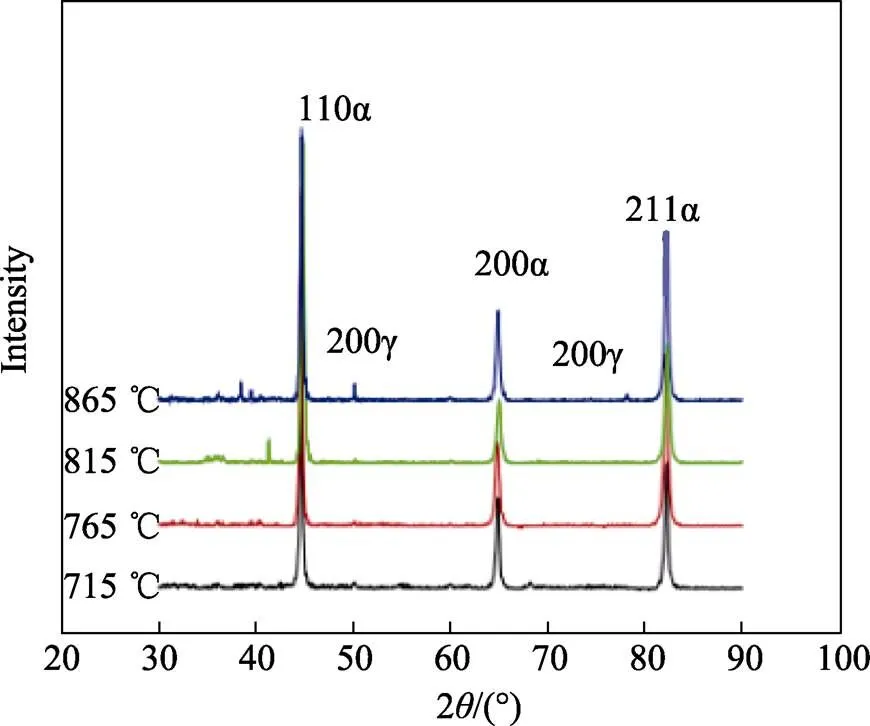
图4 不同连续退火均热温度下双相钢的XRD谱图
表2 不同连续退火均热温度下双相钢的室温拉伸性能
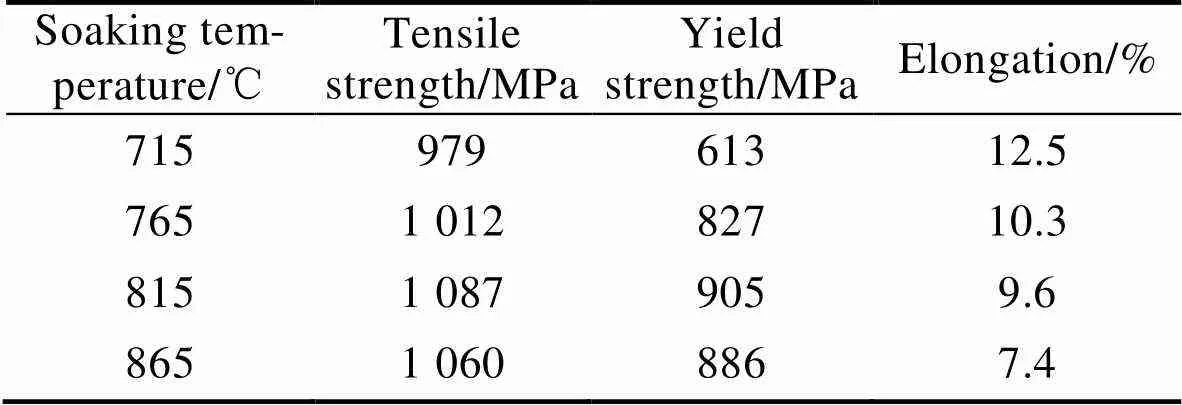
Tab.2 Room temperature tensile properties of dual phase steel at different continuous annealing soaking temperature
2.2 均热时间
当均热温度为845 ℃、过时效温度为295 ℃、过时效保温时间为5 min时,不同均热时间下双相钢的显微组织如图5所示。对比分析可知,当均热时间为0.5~5 min时,双相钢的显微组织相似,都由F+M组成,组织较为细小,且随着均热时间的延长,晶粒尺寸逐渐增大,在均热时间为3 min时,马氏体有明显粗化。
不同均热时间下双相钢的扫描电镜显微形貌如图6所示。可见,不同均热时间下,双相钢中马氏体都呈浮凸的岛状形态,晶粒尺寸随着均热时间的延长而增大,在均热时间为5 min时,晶粒尺寸明显大于其他均热时间下的晶粒尺寸。
不同连续退火均热时间下双相钢的X射线衍射图谱如图7所示。可见,不同均热时间下,双相钢仍然由α相和γ相组成。利用Jade 6.0软件计算不同均热时间下双相钢中残余奥氏体含量,当均热时间为0.5、1.5、3、5 min时,双相钢中残余奥氏体体积分数分别为7.63%、4.82%、7.51%和8.36%,可见,双相钢中残余奥氏体体积分数会随着均热时间的延长而先减后增,这主要与双相钢中碳配分和锰配分有关[17-18]。
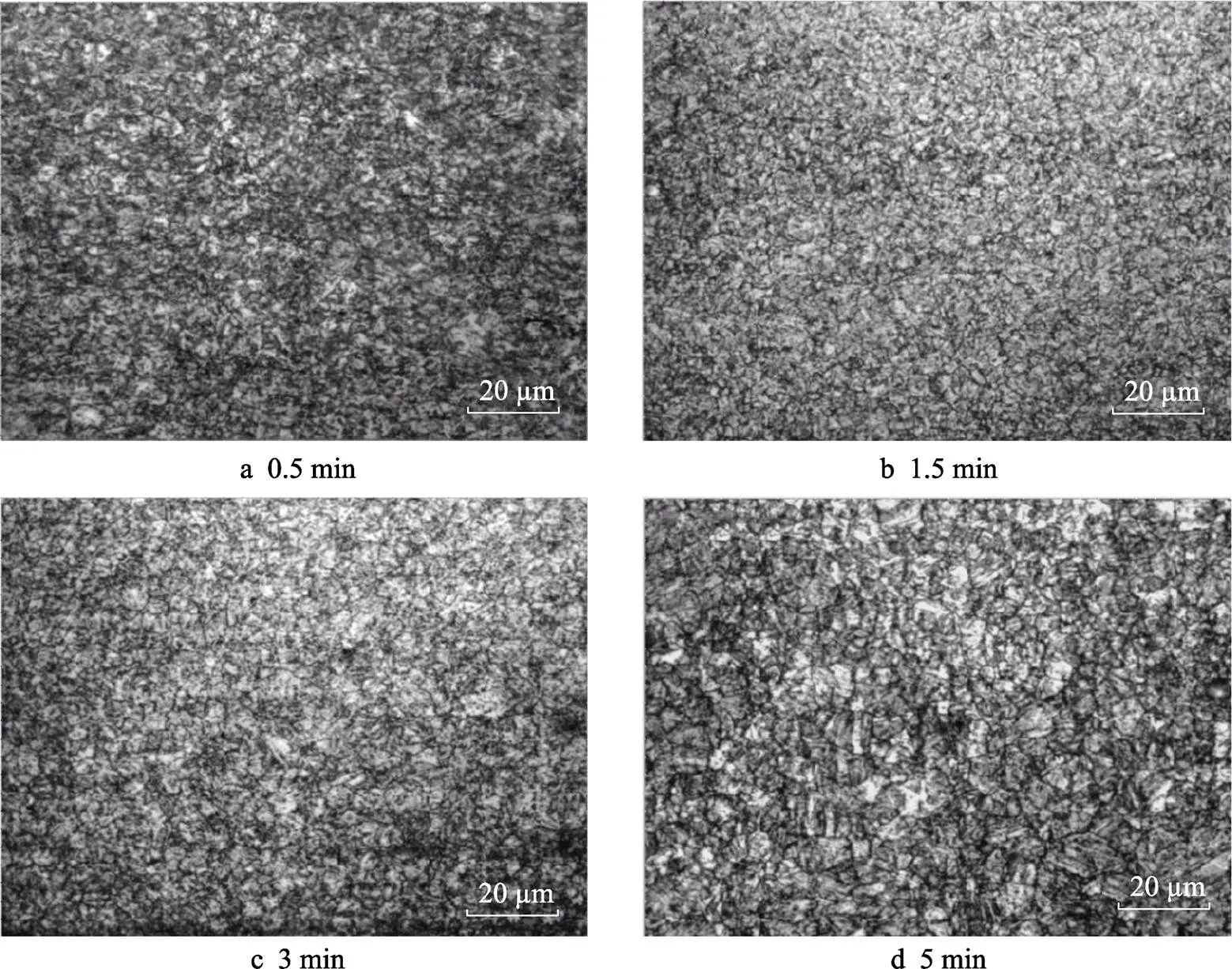
图5 不同均热时间下双相钢的显微组织
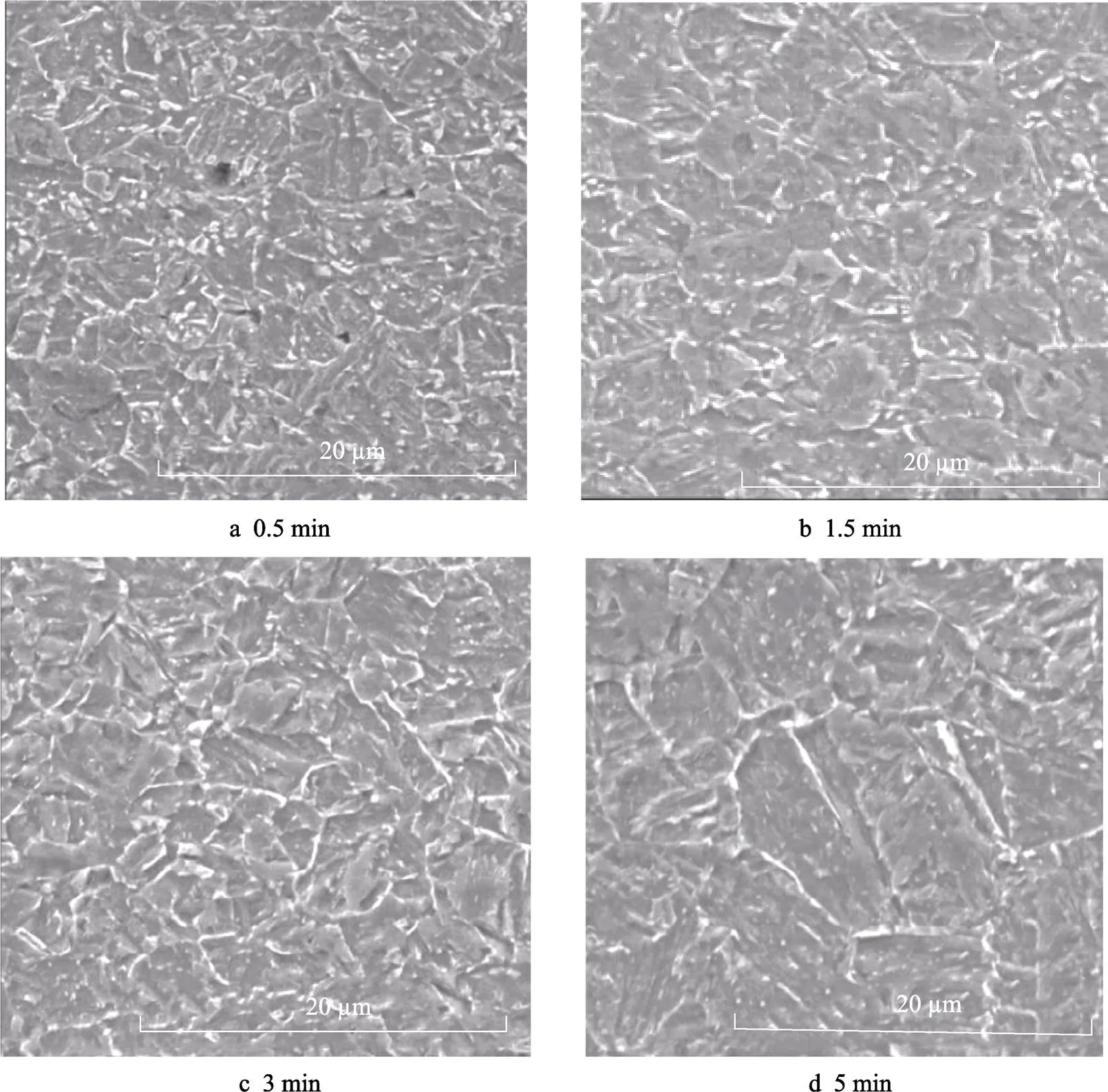
图6 不同均热时间下双相钢的SEM形貌
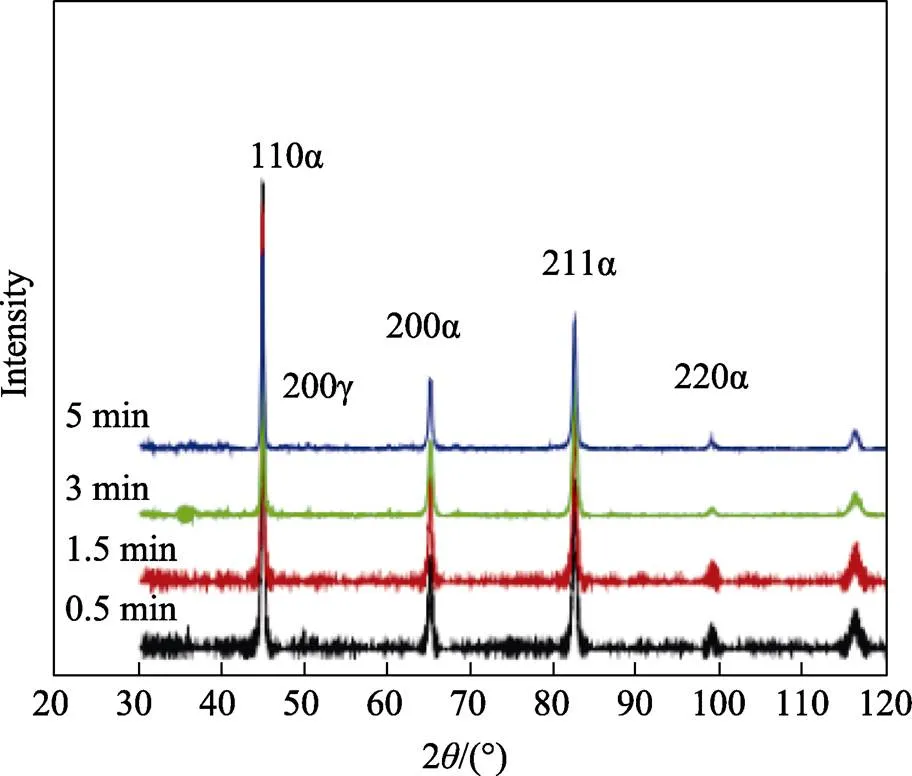
图7 不同均热时间下双相钢的XRD谱图
不同均热时间下双相钢的室温拉伸性能如表3所示。随着均热时间从0.5 min延长至5 min,双相钢的抗拉强度、屈服强度先增后减,断后伸长率先减后增,在均热时间为1.5 min时,抗拉强度和屈服强度达到最大值。这主要是因为在不同均热时间下,双相钢的组织都由铁素体、马氏体和少量残余奥氏体组成,在均热时间为1.5 min时,残余奥氏体(与马氏体相比,残余奥氏体的硬度更低、韧性和塑性更高[19-20])体积分数最小,马氏体和晶粒组织都较为细小,而在均热时间为3 min及以上时,双相钢中马氏体和晶粒会明显粗化,因此,在均热时间为1.5 min时强度较高而断后伸长率较小。
表3 不同均热时间下双相钢的室温拉伸性能
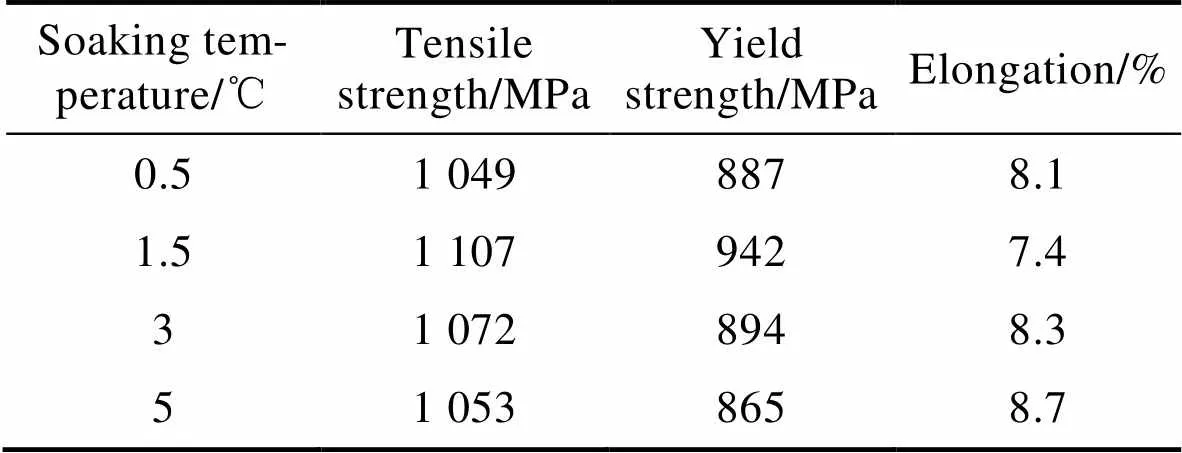
Tab.3 Room temperature tensile properties of dual phase steel for different soaking time
2.3 过时效温度
当均热温度为845 ℃、均热时间为3 min、过时效保温时间为5 min时,不同过时效温度下双相钢的显微组织如图8所示。可以看到,当过时效温度为245 ℃时,在双相钢中有针片状马氏体和亮白色铁素体组织;随着过时效温度从245 ℃上升至395 ℃,双相钢中的马氏体体积分数减小,形态有逐渐朝岛状转变的趋势,且在过时效温度为395 ℃时出现了贝氏体。
不同过时效温度下双相钢的扫描电镜显微形貌如图9所示。可见,在较低的过时效温度(245 ℃)下,双相钢的组织为针片状M+多边形F。随着过时效温度的升高,针片状M逐渐转变为岛状M,且组织中出现了贝氏体(B)。
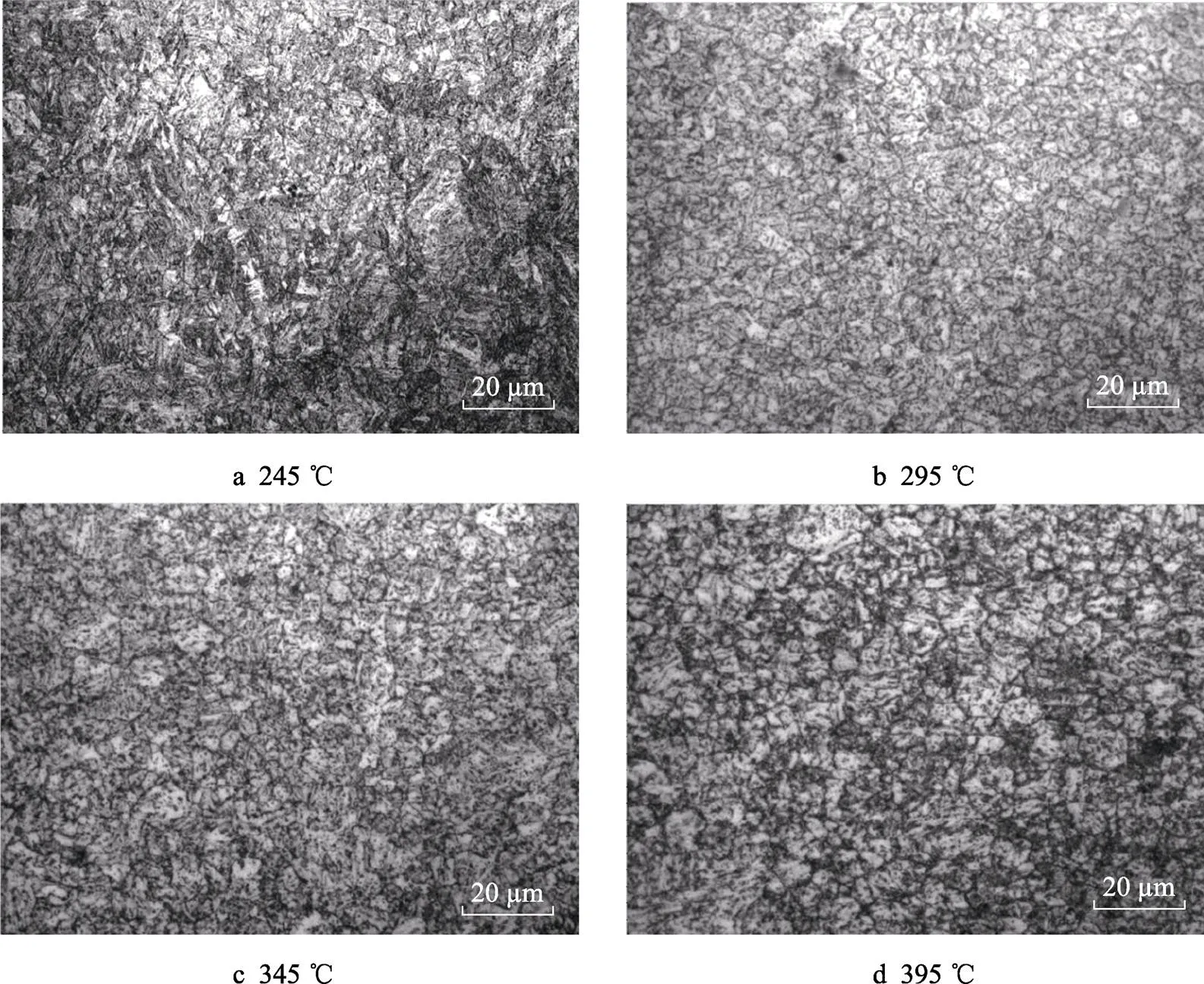
图8 不同过时效温度下双相钢的显微组织
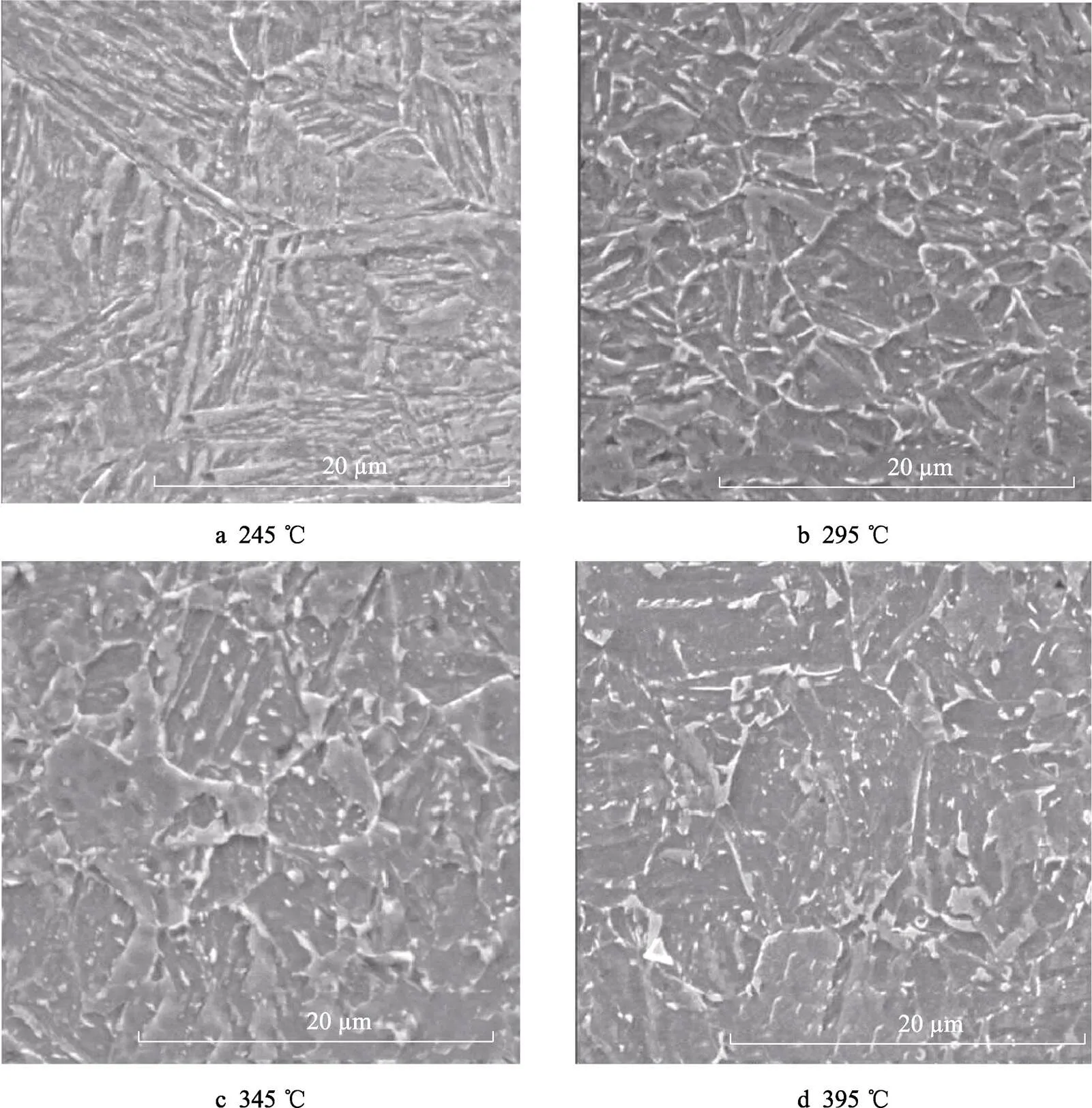
图9 不同过时效温度下双相钢的SEM形貌
不同过时效温度下双相钢的X射线衍射图谱如图10所示。在不同过时效温度下,双相钢都由α和γ相组成。利用Jade 6.0软件计算不同过时效温度下双相钢中残余奥氏体含量,当过时效温度为245、295、345、395 ℃时,双相钢中残余奥氏体体积分数分别为8.47%、8.51%、10.96%和1.12%。可见,随着过时效温度的升高,双相钢中残余奥氏体体积分数先增后减,在过时效温度为345 ℃时残余奥氏体含量最多,此时双相钢具有较高的韧塑性,这主要是因为过时效温度的升高会使碳元素的扩散能力增强,残余奥氏体含量增加[21]。而当过时效温度为395 ℃时,残余奥氏体的体积分数急剧减小至1.12%,这主要是因为此时的温度高于马氏体开始转变温度(s),组织中出现了贝氏体,残余奥氏体体积分数相对减小[22]。
不同过时效温度下双相钢的室温拉伸性能如表4所示。随着过时效温度从245 ℃上升至395 ℃,双相钢的抗拉强度、屈服强度逐渐减小,断后伸长率逐渐增大。这主要是因为在双相钢过时效处理过程中,马氏体会发生回火[23-24],且过时效温度越高,马氏体回火越充分,固溶在马氏体中的碳析出得越多[25],相应地强度会降低而塑性升高。此外,当过时效温度为395 ℃时,软相残余奥氏体体积分数较小,此时双相钢的断后伸长率与过时效温度345 ℃时的相当。
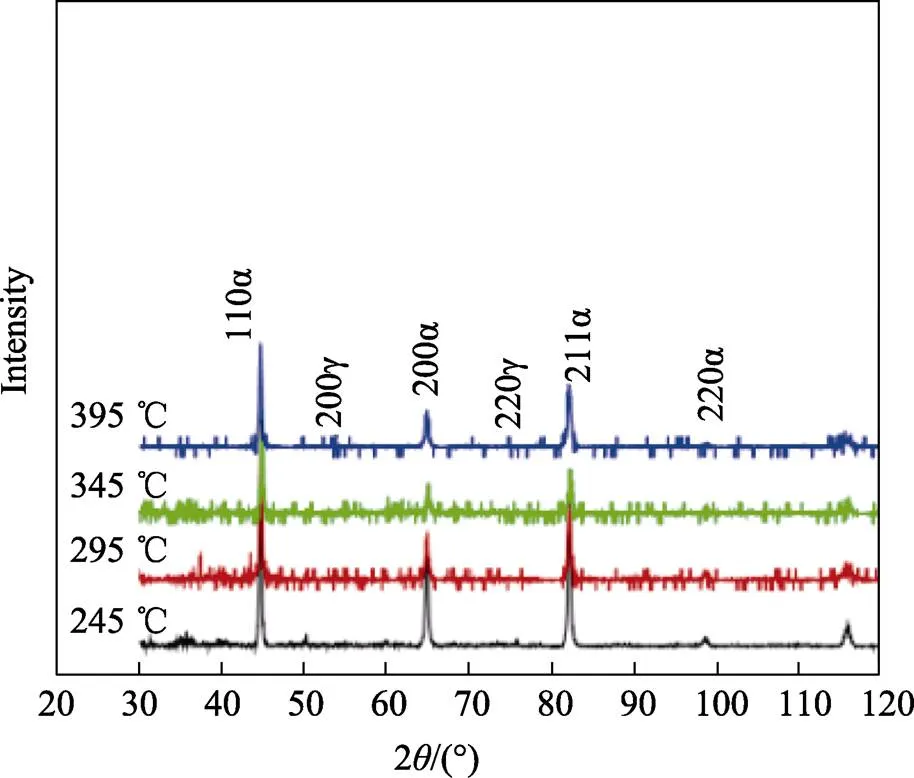
图10 不同过时效温度下双相钢的XRD谱图
表4 不同过时效温度下双相钢的室温拉伸性能
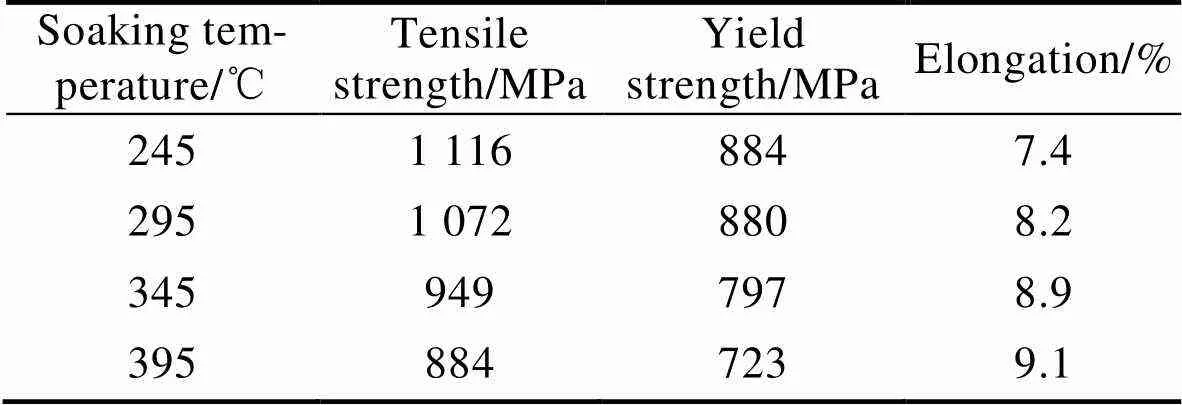
Tab.4 Room temperature tensile properties of dual phase steel at different overaging temperature
3 结论
1)对于不同退火均热温度处理的双相钢,其组织均为亮白色铁素体+黑灰色马氏体,晶粒尺寸较为细小,为2~6 µm;当均热温度为715、765、815和865 ℃时,双相钢中马氏体的体积分数分别为61.2%、67.3%、68.1%和64.5%,残余奥氏体的体积分数分别为5.63%、4.97%、3.42%和0.2%。随着均热温度从715 ℃升高至865 ℃,双相钢的抗拉强度、屈服强度先增后减,断后伸长率逐渐减小,在均热温度为815 ℃时,双相钢的抗拉强度和屈服强度达到最大值。
2)当均热时间为0.5~5 min时,双相钢均由F+M组成,且随着均热时间的延长,晶粒尺寸逐渐增大,在均热时间为3 min时,马氏体发生明显粗化。当均热时间为0.5、1.5、3、5 min时,双相钢中残余奥氏体体积分数分别为7.63%、4.82%、7.51%和8.36%;随着均热时间从0.5 min延长至5 min,双相钢的抗拉强度、屈服强度先增后减,断后伸长率先减后增,在均热时间为1.5 min时抗拉强度和屈服强度达到最大值。
3)随着过时效温度从245 ℃上升至395 ℃,双相钢中马氏体体积分数减小,形态逐渐转变为岛状,且在过时效温度为395 ℃时出现了贝氏体。当过时效温度为245、295、345、395 ℃时,双相钢中残余奥氏体体积分数分别为8.47%、8.51%、10.96%和1.12%。随着过时效温度从245 ℃上升至395 ℃,双相钢的抗拉强度、屈服强度逐渐减小,断后伸长率逐渐增大。在过时效温度为295 ℃时,双相钢具有较好的强塑性。
[1] 李麟. 汽车用高强钢的发展与展望[J]. 上海金属, 2022, 44(3): 1-8.LI Lin. Development and Prospects of High Strength Steel for Automobiles[J]. Shanghai Metal, 2022, 44(3): 1-8.
[2] 校振华, 冯亚磊, 冯启生, 等. 高强汽车中锰钢的热压缩变形行为研究[J]. 精密成形工程, 2023, 15(2): 125-131. XIAO Zhen-hua, FENG Ya-lei, FENG Qi-sheng, et al. Study on the Hot Compression Deformation Behavior of Manganese Steel in High-strength Automobiles[J]. Journal of Netshape Forming Engineering, 2023, 15(2): 125-131.
[3] WANG M X, ZHAO M A, CHEN S S, et al. Effect of Annealing Process on Microstructure and Mechanical Property of Medium-manganese TRIP Steel[J]. International Journal of Materials and Product Technology, 2022, 64(3/4): 265-277.
[4] 徐勇, 段星宇, 曾祥成, 等. 不同应变速率下DP980双相钢微观组织特征及变形机制[J]. 钢铁研究学报, 2023, 35(5): 595-604.XU Yong, DUAN Xing-yu, ZENG Xiang-cheng, et al. Microstructural Characteristics and Deformation Mechanism of DP980 Dual Phase Steel under Different Strain Rates[J]. Journal of Iron and Steel Research, 2023, 35(5): 595-604.
[5] 张春菊, 丁轩, 杨明球, 等. DP980钢的动态力学性能及本构模型构建[J]. 钢铁, 2022, 57(2): 157-161.ZHANG Chun-ju, DING Xuan, YANG Ming-qiu, et al. Dynamic Mechanical Properties and Constitutive Model Construction of DP980 Steel[J]. Steel, 2022, 57(2): 157-161.
[6] 詹华, 邹英, 周凯, 等. DP980冷轧高强钢连续退火工艺及强韧性行为研究[J]. 轧钢, 2017, 34(3): 69-73.ZHAN Hua, ZOU Ying, ZHOU Kai, et al. Study on Continuous Annealing Process and Strength Toughness Behavior of DP980 Cold Rolled High Strength Steel[J]. Rolling Steel, 2017, 34(3): 69-73.
[7] SINGH K R, CHANDRAWANSHI M, SUDHARSHAN R, et al. Optimizing Annealing Parameters with Gleeble Simulation for Cold Rolled Continuous Annealed Dual Phase Steel Sheet[J]. Materials Today: Proceedings, 2018, 5(2): 7303-7309.
[8] 单梅, 肖洋洋, 景宏亮. 退火温度对800 MPa级C-Si-Mn-Cr系冷轧双相钢组织及力学性能的影响研究[J]. 安徽冶金科技职业学院学报, 2021, 31(3): 1-3.SHAN Mei, XIAO Yang-yang, JING Hong-liang. Study on the Effect of Annealing Temperature on the Microstructure and Mechanical Properties of 800 MPa Grade C-Si-Mn-Cr Cold Rolled Dual Phase Steel[J]. Journal of Anhui Metallurgical Technology Vocational College, 2021, 31(3): 1-3.
[9] 李慧远, 戴杰涛, 冼玲标, 等. 退火温度对DP590冷轧双相钢相变和组织的影响[J]. 工程技术研究, 2020, 5(6): 1-4.LI Hui-yuan, DAI Jie-tao, XIAN Ling-biao, et al. Effect of Annealing Temperature on Phase Transformation and Microstructure of DP590 Cold Rolled Dual Phase Steel[J]. Engineering Technology Research, 2020, 5(6): 1-4.
[10] LI Y, DU J C, DING W, et al. Influence of Intercritical Annealing Temperature on Microstructure and Mechanical Properties of Medium Mn TRIP Steel[J]. Journal of Iron and Steel Research, 2018, 30(3): 185-193.
[11] NEMAI G, GULAB M W, KUMAR M S, et al. Effect of Continuous Annealing Process on various Structure Parameters of Martensite of Dual-phase Steels[J]. Archives of Civil and Mechanical Engineering, 2020, 20(1): 1-10.
[12] 王秋雨, 夏明生, 刘淑影, 等. 组织特征对980MPa级先进超高强钢成形性能和拉伸行为的影响[J]. 机械工程材料, 2023, 47(1): 100-105.WANG Qiu-yu, XIA Ming-sheng, LIU Shu-ying, et al. The Effect of Microstructure Characteristics on the Formability and Tensile Behavior of 980 MPa Grade Advanced Ultra-high Strength Steel[J]. Mechanical Engineering Materials, 2023, 47(1): 100-105.
[13] RANA A K, PAUL S K, DEY P P. Effect of Martensite Volume Fraction on Strain Partitioning Behavior of Dual Phase Steel[J]. Physical Mesomechanics, 2018, 21(4): 333-340.
[14] 周莉, 薛仁杰, 曹晓恩, 等. 高铝增强成形性双相钢980DH组织性能研究[J]. 钢铁钒钛, 2022, 43(2): 186-191.ZHOU Li, XUE Ren-jie, CAO Xiao-en, et al. Study on the Microstructure and Properties of High Aluminum Reinforced Formability Dual Phase Steel 980DH[J]. Steel Vanadium Titanium, 2022, 43(2): 186-191.
[15] DENG G Y, LIY, DI H, et al. Effect of Heating Rate during Continuous Annealing on Microstructure and Mechanical Properties of High-strength Dual-phase Steel[J]. Journal of Materials Engineering and Performance, 2019, 28(8): 4556-4564.
[16] 徐勇, 段星宇, 陈帅峰, 等. DP980高强钢静动态拉伸性能及本构模型构建[J]. 塑性工程学报, 2022, 29(6): 125-133.XU Yong, DUAN Xing-yu, CHEN Shuai-feng, et al. Static and Dynamic Tensile Properties and Constitutive Model Construction of DP980 High-strength Steel[J]. Journal of Plastic Engineering, 2022, 29(6): 125-133.
[17] 叶姜, 樊雷. 连退工艺对DP780高强汽车钢组织性能的影响[J]. 轧钢, 2021, 38(1): 80-83.YE Jiang, FAN Lei. The Effect of Continuous Annealing Process on the Microstructure and Properties of DP780 High-strength Automotive Steel[J]. Rolling Steel, 2021, 38(1): 80-83.
[18] 肖洋洋, 詹华, 崔磊, 等. 1000 MPa级微合金化冷轧双相钢退火工艺及强韧化机制[J]. 钢铁研究学报, 2019, 31(10): 912-919.XIAO Yang-yang, ZHAN Hua, CUI Lei, et al. Annealing Process and Strengthening and Toughening Mechanism of 1000 MPa Grade Microalloyed Cold Rolled Dual Phase Steel[J]. Journal of Iron and Steel Research, 2019, 31(10): 912-919.
[19] HIDEKAZU M, KYOUHEI N, TATSUYA M, et al. Effect of Tempering Conditions on Inhomogeneous Deformation Behavior of Ferrite-Martensite Dual-Phase Steels[J]. Tetsu to Hagane, 2011, 97(9): 493-500.
[20] 戴玉芬, 肖洋洋, 詹华, 等. 过时效温度对1000 MPa级冷轧双相钢的微观组织和力学性能的影响[J]. 安徽冶金科技职业学院学报, 2019, 29(2): 1-4.DAI Yu-fen, XIAO Yang-yang, ZHAN Hua, et al. The Effect of Overaging Temperature on the Microstructure and Mechanical Properties of 1000 MPa Cold Rolled Dual Phase Steel[J]. Journal of Anhui Metallurgical Technology Vocational College, 2019, 29(2): 1-4.
[21] MOHANTY R R, GIRINA O A, FONSTEIN N M. Effect of Heating Rate on the Austenite Formation in Low-carbon High-strength Steels Annealed in the Intercritical Region[J]. Metallurgical and Materials transactions A, 2011, 42(12): 3680-3690.
[22] 张兆朋, 田芳. 冷轧双相钢连续退火组织的转变分析[J]. 冶金与材料, 2018, 38(6): 186-188.ZHANG Zhao-peng, TIAN Fang. Transformation Analysis of Continuous Annealing Structure of Cold Rolled Dual Phase Steel[J]. Metallurgy and Materials, 2018, 38(6): 186-188.
[23] 甄维静, 陈俊东, 李永亮, 等. 退火工艺对1180 MPa级双相钢显微组织和力学性能的影响[J]. 钢铁钒钛, 2020, 41(4): 145-149.ZHEN Wei-jing, CHEN Jun-dong, LI Yong-liang, et al. The Effect of Annealing Process on the Microstructure and Mechanical Properties of 1180 MPa Grade Dual Phase Steel[J]. Steel and Vanadium Titanium, 2020, 41(4): 145-149.
[24] ZHANG F, RUIMI A, WO P C, et al. Morphology and Distribution of Martensite in Dual Phase (DP980) Steel and Its Relation to the Multiscale Mechanical Behavior[J]. Materials Science and Engineering A, 2016, 659: 93-103.
[25] AMIT K R, SURAJIT K P, PARTHA P D. Effect of Martensite Volume Fraction on Cyclic Plastic Deformation Behavior of Dual Phase Steel: Micromechanics Simulation Study[J]. Journal of Materials Research and Technology, 2019, 8(5): 3705-3712.
Continuous Annealing and Microstructure and Properties of High Strength Automotive Dual Phase Steel
YANG Can1, XIAO Zhen-hua1, FENG Qi-sheng2,3, LUO Zhi-hui3
(1. Henan Vocational College of Agriculture, Zhengzhou 451450, China; 2. Henan University of Science and Technology, Henan Luoyang 471000, China; 3. Luoyang Zhongzhong Casting and Forging Co., Ltd., Henan Luoyang 471000, China)
The work aims to improve the mechanical properties of high strength DP980 dual phase steel and optimize the continuous annealing process.Continuous annealing treatment was conducted on high strength automotive dual phase steel, and the effects of soaking temperature, soaking time, and overaging temperature of continuous annealing on the microstructure, phase composition, and mechanical properties of cold rolled dual phase steel were studied. The microstructure of dual phase steel treated at different soaking temperature was divided into ferrite (F) and martensite (M). With the soaking temperature rising from 715 ℃ to 865 ℃, the volume fraction of residual austenite gradually decreased, the tensile strength and yield strength firstly increased and then decreased, the elongation gradually decreased and the maximum tensile strength and yield strength of dual phase steel were obtained at the soaking temperature of 815 ℃. As the soaking time increased from 0.5 min to 5 min, the grain size of the dual phase steel gradually increased, the volume fraction of residual austenite firstly decreased and then increased, the tensile strength and yield strength firstly increased and then decreased, the elongation firstly decreased and then increased, and the maximum tensile strength and yield strength were obtained when the soaking time was 1.5 min. With the overaging temperature rising from 245 ℃ to 395 ℃, the volume fraction of martensite in dual phase steel gradually decreased, and bainite appeared when the overaging temperature was 395 ℃. Otherwise, the volume fraction of austenite firstly increased and then decreased, the tensile strength and yield strength gradually decreased, and the elongation gradually increased. The suitable continuous annealing process for cold-rolled DP980 dual phase steel is: soaking temperature of 815 ℃, soaking time of 3 min, and overaging temperature of 295 ℃, which can make the dual phase steel have good strength plasticity.
DP980 dual phase steel; continuous annealing; process parameters; microstructure; property
10.3969/j.issn.1674-6457.2023.10.020
TG156.2;TG142.1
A
1674-6457(2023)10-0168-09
2023-06-14
2023-06-14
河南省科技攻关项目(192102310244)
Science and Technology Research Project of Henan Province(192102310244)
杨灿, 校振华, 冯启生, 等. 高强汽车双相钢的连续退火与组织性能研究[J]. 精密成形工程, 2023, 15(10): 168-176.
YANG Can, XIAO Zhen-hua, FENG Qi-sheng, et al.Continuous Annealing and Microstructure and Properties of High Strength Automotive Dual Phase Steel[J]. Journal of Netshape Forming Engineering, 2023, 15(10): 168-176.
责任编辑:蒋红晨

